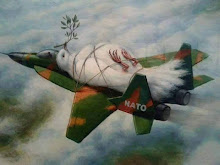
I am writing from Nagpur on Oct 10 but not certain when I will be able to post this, as I have no Internet connection at this time. I am staying in a guesthouse that the state ministers use when they come to Nagpur each year for the state assembly that meets for a couple of weeks. It is a humble room with bed, two chairs, a desk, and an Indian-style bathroom. Lucky for me it is air conditioned, as Nagpur seems to have a reputation as one of the hottest places in India. Nagpur is located about mid-center in the country.
I arrived here early yesterday morning after a 5:50 am flight from New Delhi. The plane stopped in Raipur first to drop off, and pick up, more passengers as it made its three-legged route between the cities.
Our Global Network board member J. Narayana Rao was waiting for me in Nagpur when I arrived. Rao is our key contact in the country, a retired railroad union man, who discovered the space issue some years ago while on our mailing list. He was organizing the GN’s international space conference that was to be held this weekend but was not allowed by the Indian government, which had to give permission under their archaic definition of democracy.
So instead, Rao quickly changed course and turned the event into a national conference, which successfully began late yesterday afternoon with more than 200 people attending.
I had lunch yesterday with the man who was invited to be the keynote speaker for the conference. His name is Admiral Vishnu Bhagwat, the former Chief of the Indian Navy. This tall and slender man, with shining dark eyes, is a breath of fresh air. I learned that he had been “sacked” from his post a dozen years ago for speaking out against government policies. He was to become the Chairman of the Joint Chiefs of Staff but the U.S. opposed his appointment and made sure he was forced out of power.
Two local newspapers this morning carried stories from a news conference Bhagwat held after his talk yesterday to the conference. One headline read: “Defence is the biggest corrupt sector” and the other “U.S. still funding terrorist outfits.” From the latter article: “Bureaucrats play stooges to arms manufacturers, deals are signed with greased palms, defence continues to be the most corrupt sector and government is feigning innocence. Nothing has changed. On the international front, U.S. continues to fund terrorist outfits including those in Pakistan,” Bhagwat said.
A truly independent man, Bhagwat confirmed my long held belief that the corporate international oligarchy is now taking over virtually all the governments of the world. The goal? Corporate domination of resources and markets with expanding militarism to be the tool of control.
Here are a few bits from his excellent speech last night:
“It is the policies of this [global corporate] oligarchy which determine priorities of national budgetary allocations on weapons systems and their expansion into space to target the planet earth, and for use in the oceans, and the seabed.
“As we see the world order today, the material conditions of the people from one continent to the other, the direct consequences of colonialism, breeding predatory wars for resources and markets, and conflicts within nations ….to further consolidate an extremely exploitative, parasitical and colonial regime to crush the ‘untermenshens’ or sub-humans which is the expression for the ordinary people of this planet, as never before at any time in world history. In our own country, Mahatma Gandhi and Jawaharlal Nehru had described these conditions as the ‘terror of hunger and unemployment’, thinking they were inherent characteristics of those times in colonial India and would be eradicated when freedom was won!
“We are seeing a greater disdain for the basic principles of international law. We are witnessing an almost uncontained hyper use of force in international relations, force that is plunging the world into an abyss of permanent conflicts. I am convinced that we have reached the decisive moment when we must seriously think about the architecture of global security.
“A ‘Permanent War’ system nurtured by a permanent ‘War Economy’, fed by the predatory practices of Big banks and the multi-national corporations has led to the establishment of the National Security State which in turn advances the private interest of the financial oligarchy. The three golden rules, therefore, are US/NATO global military presence, global projection of military power and the use of that force in one conflict or the other to threaten the ‘lesser people’ of the world with ‘Full Spectrum Dominance’ – including in space. The ruling classes are actually an alliance of the ‘Transnational Capitalist Class’, which delivers to itself profit, power and privilege through policy control and weaponisation.
“Either the Transnational Capitalist Class alliance self-destructs, compelled by the conscious mobilization of the working people in solidarity across the continents, those who oppose war and stand solidly together in a counterforce on the side of humanity, or we go further downhill the slope of lower depths, into an abyss. For every person there are always two choices in life: to accept things as they are or to accept the responsibility to bring about change – from a war economy to a political economy of peace to share, to preserve our environment and to belong to the commons in which every being has an equal stake for our minimum needs.”
Following his talk we showed the new documentary Pax Americana and the Weaponization of Space. At the end I was besieged by many people that wanted a copy of the film.
Rao was particularly thrilled that about 60 students from colleges and universities across the country had come for the conference. He has been traveling across India for the past five years promoting the space issues work of the Global Network and it appears that his efforts are bearing fruit. I was very impressed by the sharpness and serious character of the students present and after the film was over I met professors from these same schools across the nation who also had come to Nagpur. They were teachers/students from many disciplines such as: political science, business, pharmacy, commerce, metallurgy and engineering. And these are just the few that I met.
Today the conference resumed and I spoke about the new “Strategic Partnership” between the U.S. and India. Increasingly the Pentagon is drawing the Indian military into the space weaponization game as a way to help create a military alliance against China.
In one session two women students spoke about the dangers of nuclear weapons and the links between nuclear power and building nuclear weapons. One of the young women, a fiery speaker, was so impressive that I invited her to accompany Rao to the U.S. next year for the GN’s 2011 international space conference. She said that she would be happy to come along.
At the end of today’s conference I was approached by a group of students and their professor from a social work college in Nagpur to tell me they were excited about my planned visit to their school tomorrow. In addition, a group of four people from Bhopal, where I will visit next, told me they wanted to welcome me in advance of my visit.
Rao and I will take the night train from Nagpur to Bhopal on October 11. I have long known of the Union Carbide accident there years ago that killed thousands of local citizens. I’m sure I will learn more about the famous disaster and look forward to that visit.
I will post more when I can but wireless connection is a rare find here. So far I have been luck to get online by a metallurgy professor at a Nagpur college.






























